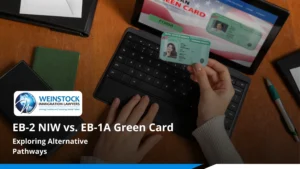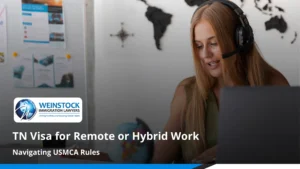What is the H-1B Visa – What You Need to Know
In this age of rapid economic growth and demand from companies for technology and other workers which outpaces the supply, many U.S. companies rely on foreign-born employees to cover their hiring needs. Recruiting and retaining the best possible talent from around the world is critical for any business to maintain its competitive edge. Many businesses need to hire professionals directly from abroad or find foreign talented graduates from U.S. universities.
The H-1B Visa
The H-1B is the primary method for bringing professional foreign employees to work temporarily in the United States. It is an employer-sponsored process and intended for foreign workers specialty occupations, i.e., ones that normally require a bachelor’s degree. H-1B visas are granted for a maximum of 6 years and typically filed in 3-year increments. The spouse and children of an H-1B worker may apply for H-4 visa status.
The H-1B Visa Cap
There are a limited number of H-1B visas available per each calendar year. The current H-1B visa cap is 85,000 employees in total, 65,000 are allotted for employees with at least a bachelor’s degree or its equivalent and 20,000 visas are allotted for employees with at least a U.S. master’s degree.
When USCIS receives more petitions than it can approve, petitions are put in an H-1B Visa Lottery, which is a system created to randomly choose which H-1B petitions will be considered. The petitions that were not selected are returned with the filing fees and rejection letter. This does not prevent applicants from applying in a subsequent year or applying in a cap-exempt status, but it does pose additional hardships on H-1B visa applicants and their employers as there is no guarantee their petition will even be considered.
The Prevailing Wage Requirement
The employer is the petitioner of the H-1B visa application. The employer must ensure that the H-1B worker will be paid at least the wage paid to similarly employed workers in the same geographic area where the H-1B worker will be employed. This wage, known as the “prevailing wage,” is determined by outside wage surveys that the Department of Labor (DOL) and other private companies conduct for each metropolitan area in the U.S. The employer must also ensure that the H-1B worker’s salary is not less than the actual wage. This is the wage that the employer pays other employees with similar qualifications.
Labor Condition Application
The first step in the H-1B process is the submission of the Labor Condition Application (LCA) with the U.S. Department of Labor. The process takes at least 7 days and must be filed electronically through the DOL’S iCERT Portal.
Specialty Occupation
To qualify as a specialty occupation, the position that is offered to the H-1B worker must require at least a U.S. bachelor’s degree or its equivalent. This requirement can be satisfied in different ways, but it has to pass common sense. For example, if a restaurant wants to sponsor a server for an H-1B, requiring a bachelor’s degree for that position would simply not suffice. Often USCIS even questions jobs that are clearly specialty occupations, so the standard is rather high. The agency is less likely to approve new or unconventional occupations.
In addition to proving that the position is in a specialty occupation, the application must demonstrate that the worker has the necessary educational or professional background to perform the job duties. A foreign worker’s education must be equivalent to a U.S. bachelor’s degree and this is determined by course credits. For example, most 3-year Bachelor of Commerce degrees from India are not considered equivalent to U.S. bachelor’s but only 3 years of college, whereas a 3-year undergraduate degree from the United Kingdom is generally deemed equivalent.
If the worker does not have a bachelor’s degree in a field related to the position, he or she can still fulfill this requirement through work experience or a combination of education and experience. The formula used by USCIS indicates that three years of documented related work experience are equivalent to one year of college studies. However, the work experience must be professional and progressive in order to qualify. For example, someone without a college degree will require 12 years of experience, while another with a 3-year Indian Bachelor of Commerce degree will require 3 years of related experience to meet this criterion.
Many H-1B filings include foreign students on F-1 visa usually under OPT – Optional Practical Training. The OPT is a work card that allows foreign students graduating from a degree they obtained in the U.S. to work for U.S. employers in their field. Most U.S. employers hire these graduates into their workforce and normally wish for them to continue working after they have trained them for a year. However, there are challenges that arise because most OPT cards are only valid for one year. Some can be extended beyond two years if the student graduated from a STEM occupation and the employer participates in e-verify. If the student is not selected for the H-1B visa lottery and has an approved visa within the year of their OPT work card expiring, the employer may lose the employee. Therefore, advanced planning is required as well as a good strategy for each individual case to succeed.
Related posts

Exploring Alternative Pathways: EB-2 NIW vs. EB-1A Green Card
Summary Two of the most sought-after green card options for highly qualified professionals are: EB-2 National Interest Waiver (NIW) EB-1A Extraordinary Ability visa Both allow

TN Visa for Remote or Hybrid Work: Navigating USMCA Rules
Summary If you’re a Canadian or Mexican entrepreneur living in the U.S. or planning to launch a business here, you may be wondering: Can I

Impact of USCIS Policy Updates on EB-2 NIW Petitions: What You Need to Know
Summary The EB-2 National Interest Waiver (NIW) offers a pathway to U.S. permanent residency without employer sponsorship, ideal for professionals and skilled workers. Recent USCIS
